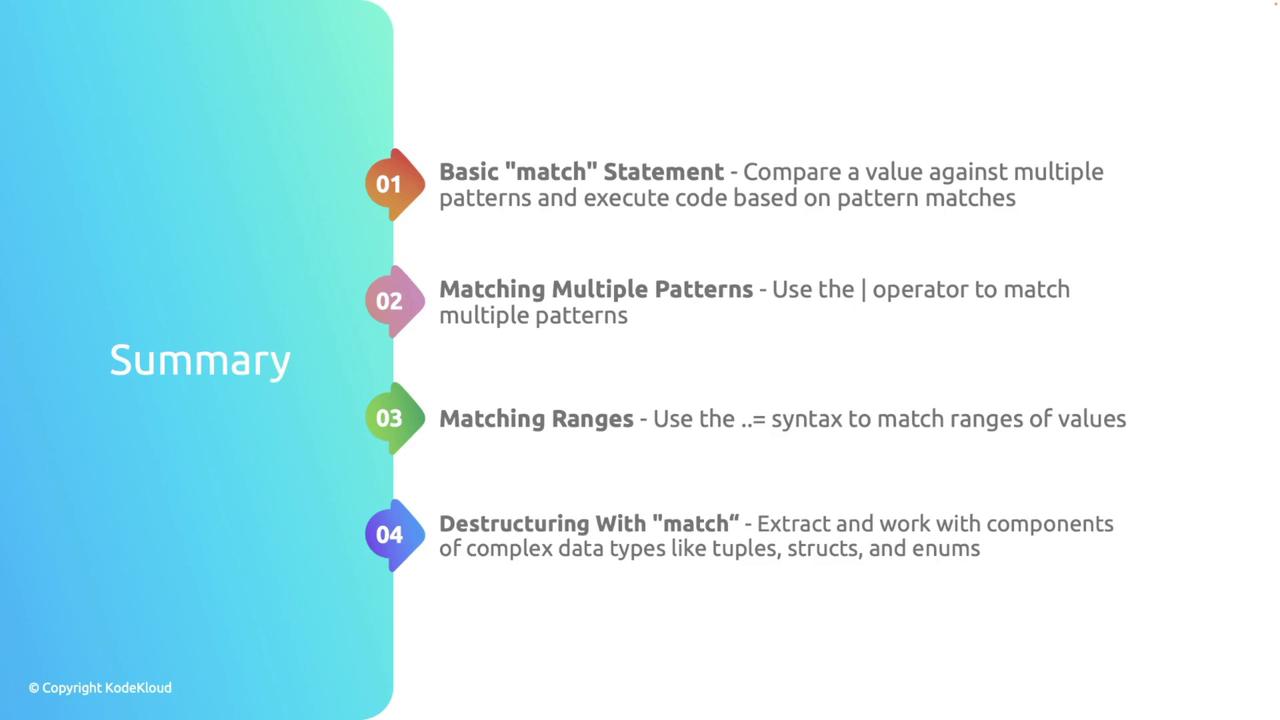Rust Programming
Rust Basics
Control Flow Pattern matching with match
Pattern matching using the match statement in Rust is one of the language's most powerful control flow constructs. It allows you to compare a value against a series of patterns and execute corresponding code blocks for the first pattern that matches. This approach is more robust than traditional switch statements in other languages because Rust's match statement supports an extensive range of pattern types—such as literals, variables, wildcards, tuples, and enums—enabling you to write concise, expressive, and maintainable code.

Basic Syntax
Below is a simple example demonstrating the basic syntax of the match statement. You specify the value to evaluate after the keyword match and then define a series of arms. Each arm consists of a pattern followed by a block of code that executes if the match is successful:
match value {
pattern1 => {
// Code to run if pattern1 matches
},
pattern2 => {
// Code to run if pattern2 matches
},
_ => {
// Code to run if no other patterns match (optional)
},
}
Example: Matching a Number
In this example, a number is compared against several specific patterns, with a default case to handle all other values:
fn main() {
let number = 3;
match number {
1 => println!("One"),
2 => println!("Two"),
3 => println!("Three"),
_ => println!("Something else"),
}
}
Since the number is 3, the output will be:
Three
Using the OR Operator
Rust allows you to match multiple patterns for a single arm by using the OR operator (|). This feature makes it simple to execute the same block of code for multiple specific values:
match number {
1 | 2 | 3 => println!("One, two, or three"),
_ => println!("Something else"),
}
Consider this complete example when the value is 2:
fn main() {
let number = 2;
match number {
1 | 2 | 3 => println!("One, two, or three"),
_ => println!("Something else"),
}
}
Output:
One, two, or three
Matching Value Ranges
A useful feature of Rust's match statement is the ability to match ranges of values using the ..= syntax. This allows you to check if a value falls within a specific range:
fn main() {
let number = 7;
match number {
1..=5 => println!("Between one and five"),
6..=10 => println!("Between six and ten"),
_ => println!("Something else"),
}
}
Since 7 is within the range of 6 through 10, the output will be:
Between six and ten
Destructuring Complex Data Types
Rust's match statement is not limited to simple values. It also supports destructuring of complex data types like tuples, structs, and enums, enabling you to work with their individual components efficiently.
Destructuring a Tuple
The following example demonstrates how to destructure a tuple and add conditional extractions with additional logic:
fn main() {
let pair = (2, -2);
match pair {
(x, y) if x == y => println!("The numbers are equal"),
(x, y) if x + y == 0 => println!("The numbers are opposites"),
_ => println!("No special properties"),
}
}
For the tuple (2, -2), the second arm is executed because the numbers are opposites.
Ignoring Unneeded Values
Sometimes you may only need part of the data from a tuple. In such cases, you can use the wildcard _ to ignore the parts that are not required:
fn main() {
let pair = (2, 8);
match pair {
(x, _) => println!("The first number is: {}", x),
}
}
This code will produce the output:
The first number is: 2
Note
Rust’s match statement ensures that all cases are covered at compile time, providing a safeguard against unexpected values.
Summary
Pattern matching with the match statement in Rust provides a flexible and elegant way to handle decision-making in your code. In this article, we covered:
- The basic structure of a match statement for comparing a value against multiple patterns.
- Using the OR operator (
|) to handle multiple patterns in a single arm. - Matching ranges of values with the
..=syntax. - Destructuring complex data types such as tuples and selectively ignoring parts of a pattern.

Thank you for reading this article on Rust's pattern matching. For more information and advanced examples, consider exploring Rust’s official documentation.
Watch Video
Watch video content
Practice Lab
Practice lab